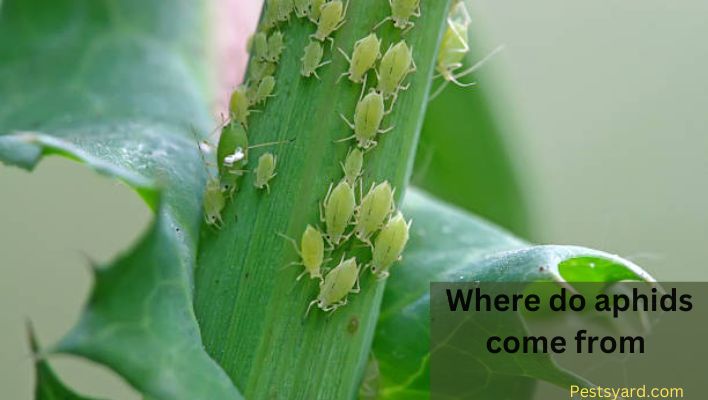There are more than 400 species of aphids, and some are probably flying around your garden and trees. Some species are harmless, but many are pests that can damage and kill plants. The first step to managing aphid infestations is knowing where they come from, or what attracts them to your home.
The aphid problem is something that will be around for a while. The tricky thing is that they don’t just come from one place. To make things even worse, they will likely continue to find new ways to infiltrate your garden, crops, and trees.
Aphids are small insects that feed on plants and suck their sap. They are sometimes annoying because they can cause spots, stunting, and even death in some plants.
Aphids are one of the most common pests in the world, but they don’t just affect plants in greenhouses; they also may attack houseplants, outdoor landscapes, and garden crops. Some aphids are so big that they are visible to the naked eye, while others are small enough to fit on a pinhead.
About Aphids
Aphids, also known as plant lice, are small soft-body insects that appear on the surface of plants. They are insects that live on many different types of plants and trees. There are several species of aphids, but most people only see one or two.
The most common aphid species is the green peach aphid (Aphis pomi). These aphids have green bodies with antennae and legs. They are also other colors, such as orange, pale yellow, black, light red, blue, and many more.
Unlike other insects, aphids prefer to live under the leaves of plants, which they feed off of by sucking out their sap. They mainly infest leafy vegetables such as tomato buds, roses, sunflowers, peppers, and many more. They are also common on fruit trees.
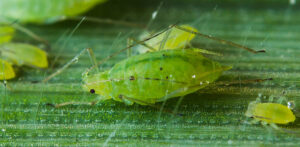
Their preferred host plant is tobacco (Nicotiana tabacum), but with some varieties, this can be changed to squash or corn, yet many species of true aphids cause damage to tomato plants and others.
When aphids invade a garden or home landscape, they can quickly darken your favorite plants and spread disease. They thrive in warm weather and can spread quickly by traveling from plant to plant.
Aphid populations typically peak in late spring or early summer when favorable weather conditions occur before aphid populations wither away during late summer through fall seasons. They can cause stunted growth and may also affect the taste or appearance of your produce.
The life cycle of an aphid starts with an egg laid on the plant. These eggs are laid during winter and will hatch in the next summer. When they hatch, they start feeding on plant sap, which could cause their host plant leaves to curl up, yellow or brown, and stunt growth in the general plant appearance.
What aphids look like
Aphids are small, soft-body insects that feed on the plants you grow. They can often be found on your crops’ leaves and cause serious damage to the plant if not caught early enough.
Aphids have a pear-shaped bodies and are covered in small, black, or brown bristles. Their bodies are usually between 0.7 and 1 inch long, but they can grow up to 3 inches long. Aphids reproduce rapidly, so it is important to check your plants regularly for aphids, especially young ones.
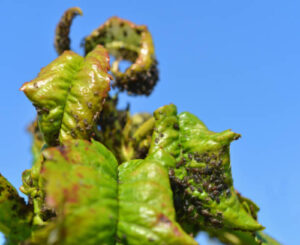
What causes aphids to appear?
Aphids are tiny insects that suck the sap from a plant’s leaves. The sap causes leaves to curl and turn brown; when this happens, the plant dies, and aphids migrate to other plants.
Aphids come from many places. A nearby garden or field is one of the most common sources of aphids. They can also be transported by wind, water, and animals.
An aphid infestation can be caused by various conditions, including drought, poor drainage, a wet environment, and a lack of nitrogen fertilizers.
In your home, aphids might be caused by overcrowding or poor sanitation. They have also been known to hitchhike on people’s clothing, shoes, or equipment used in construction projects or gardens.
Aphids can come from many sources:
- Wild populations of aphids have been found in areas with a lot of plant growth (such as gardens).
- They can also be brought into your garden by birds or other animals.
- The most common method of transmission is through seeds or plants planted in soil where aphids have been found before.
They’re often a sign of plant stress, but they also appear in some environments as a result of certain conditions, which are:
- Low soil moisture
- Low air temperature
- High humidity
The biggest factors in their spread are humans who bring them into their homes or gardens and the weather conditions that cause them to hatch and be active outside in the first place.
Problems caused by Aphids
Aphids can be a nuisance to plants and gardeners, but they’re also a real problem for farmers and commercial growers. They destroy crops, weaken plants and cause heavy damage to fruits and vegetables.
Aphids are tiny insects that suck the juices from plants. They’re often found on roses, tomatoes, pepper vines, kale, and other leafy greens. They’re also very common in citrus trees and shrubs.
Aphids also transmit viruses that affect other plants, like tomato plants causing leaf curl, eventually leading to death when left untreated due to a lack of nutrients from damaged leaves.
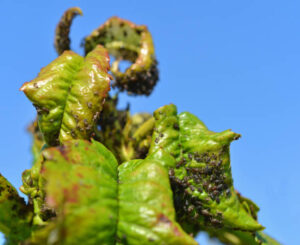
They can be mistaken for tiny ants because they have wings but are part of a different insect family. Aphids can cause damage to plants in a variety of ways, including:
- They excrete honeydew, which can attract ants and other pests to the plant.
- They spread fungal diseases like oomycetes.
- They suck up fluids from the roots of plants, causing them to wilt or die.
The feeding damages the plant, causing it to lose nutrients and become stunted or unhealthy.
You’ll know you have an infestation if you find many tiny green pearls all over your plantings—these tiny creatures secrete a sticky substance called honeydew as they feed on plant sap at night while hiding under leaves during the day (which can cause unsightly sooty mold growth)
When aphids come out
Aphids are often found in the spring, but they can appear at any time of year. Aphids are short-lived insects that feed on plants by sucking sap from their leaves. They are most commonly encountered when they emerge from their overwintering sites and begin to feed on newly sprouted vegetation.
However, aphids can sometimes be found during the fall months as well. They may have spent the summer hiding in protected spots until conditions were right for them to emerge again. If you find an aphid pheromone lure near your plants this fall, it may help you attract these insects back into your garden.
It is important to note that several different species of aphids occur, and each species has its own specific biology and behaviors.
- The first is when the weather warms up, which will be springtime in most parts of the world; this is also known as ‘bloom.’
- Second, the second brood of aphids hatch about seven days after the first group of aphids hatched and are ready to feed on plants, so these may appear more frequently around this time.
- Third, it is said those on chilly nights, when temperatures get down less than 15 degrees Celsius (59 Fahrenheit), aphid populations can double overnight.
However, they’re not the only insects that emerge during these periods. Below is a list of other insects that come out in the spring:
- Cucumber worm
- Black aphids
- Green peach aphid
- Mealybugs
While it’s true that some of these insects can cause damage to plants, aphids are the most common type of insect in your garden. They’re a nuisance because they can weaken plants by sucking up their nutrients.
Where aphids lay eggs
Usually, aphids reproduce parthenogenically, meaning they can produce fertile offspring without mating. This is interesting because all other insects have to mate to create their next generation, which can sometimes be a problem since female aphids lay many fertile eggs anyway.
Aphids lay eggs on the underside of leaves. Look for tiny white spots on the underside of the leaves, especially on the veins. They can also lay them on stems and in the soil. The eggs are very tiny, and they look like small white dots.
Are aphids harmful to humans?
They’re not harmful to humans. Aphids are pretty harmless to other animals and humans, but they can do some damage if they’re on your houseplants or trees. If you see aphids, it’s best to remove them from the plant or tree and dispose of them to prevent the spreading of the infestation.
Aphids are generally harmless to humans, although they can sometimes cause minor irritation due to their high numbers on your skin. This irritation is usually temporary and doesn’t last long, though if you have sensitive skin, this may be an issue for you.
If you find yourself with an infestation of aphids on your plants or houseplants, you should take steps to get rid of them. You can use insecticides or pesticides that are safe for humans, but these should be used only as instructed by your local garden center staff or pest control specialist.
How to prevent aphids
Aphids can appear suddenly and multiply very quickly. The good news is that most aphid problems are easy to control with preventative methods. If you suspect your garden is affected by aphids, here’s what you need to do first.
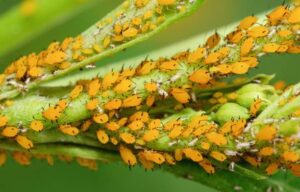
The causes of aphids are complex, with many factors at play. But there are some things that you can do to prevent them from appearing in your garden:
- Planting resistant varieties of plants is one way to prevent aphids from appearing.
- Mulch around your plants with straw or sawdust. This will keep the soil cool and moist and discourage weeds from growing.
- Keep weeds under control, as they will provide food for aphids and other pests.
- Plant nitrogen-fixing crops such as peas and beans alongside other crops that need more nitrogen, like tomatoes and squash. These crops help the nitrogen in your soil become available for other plants.
- Don’t let water sit on the ground too long after it’s been applied to your plants because this can encourage aphids and their eggs to develop there instead of being washed away by rainwater or irrigation systems later on down the line (this also applies to rainy days when water might not be applied for a while).
- Before you buy any plants, be sure to check for aphids. If you see them, don’t buy them.
- Keep your garden clean and well-maintained so that there’s no place for aphids to hide. Clean old leaves and debris from around your plants regularly so they can get a good start with their lives.
- If you have a problem with aphids in particular areas of your garden, try sprinkling diatomaceous earth around those areas before harvest time—it will be dead by then and won’t harm any plants’ health or appearance to kill off any aphids that happen.
- Check your garden regularly for signs of infestation, including leaves with green mold or white spots on the underside of leaves.
If you see aphids, contact the nearest extension office for advice on what to do next (for example, spraying insecticides around baseboards or sprinkling insecticidal soap around baseboards).
Killing aphids with soapy water
Soapy water is the safest and most effective way to kill aphids and other soft-body pests. Soapy water will help to kill aphids by coating their body and preventing them from absorbing water or nutrients from the plant. It also causes them to dehydrate quickly and die within a few hours of exposure to soapy water.
Mix one tablespoon of dish soap with one quart of water in a spray bottle to use soapy water. Spray this mixture over your plants every day until you have killed all of your aphids or moved elsewhere (which will probably happen nearly as soon as you start using soapy water).
You may want to supplement your soapy water treatment with insecticidal soap if it doesn’t seem to be working as quickly or well on some parts of your plants (such as leaf undersides). Insecticidal soap contains pyrethrum – an effective natural insecticide derived from flowers – which works well against aphids.
Natural aphid spray vinegar
Vinegar kills aphids by dehydrating them and causing them to die. It also has antibacterial properties, which can help curb mold and mildew spread on your plants.
The best thing about this spray is that it’s so easy to use. All you have to do is gently spray your plants with the solution at least once a week or as needed, depending on the severity of the infestation. This will ensure that you don’t end up with nasty bugs making their way into your garden.
This DIY insecticide is easy to make and inexpensive. It works well on aphids, whiteflies, and other soft-bodied insects that like to suck sap from plants.
You will need:
1 cup of white or apple cider vinegar
3 cup water
4 drops of dishwashing liquid (or a few drops of dish soap)
Mix all ingredients in a spray bottle. Shake well before each use. Spray on infested areas every day for two weeks until all aphids have been eliminated from your garden or landscape area. Vinegar is safe for pets and children; however, using too much vinegar on your plants will burn them.
Other natural ways to get rid of aphids
Aphids are a huge problem in the gardening world. They can be a pain to get rid of and can cause damage to your plants. Chemical pesticides and insecticides are bad for the garden, and natural methods have also proven effective.
Below are some natural ways to eliminate aphids without using harmful chemicals or pesticides.
Use aphids as natural predators
There are many natural predators that will kill aphids. Some of them are ladybugs, lacewings, parasitic wasps, and hoverflies. Ladybugs are tiny insects that eat aphids and can live on plants all year round.
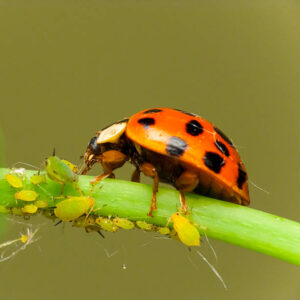
Lacewings are another great predator that lives on aphids throughout the season. They will lay their eggs on the aphid, so when they hatch, they will eat their host animal – an aphid. They also have many different colors, so you can easily find them if you need them for your garden.
Parasitic Wasps are also great predators of aphids because they will lay their eggs inside the infected plant tissue. When these wasps hatch from their eggs, it will kill the aphid from the inside out.
If you want to use these predators to get rid of aphids without using pesticides, you’ll need to ensure that these predators have access to a source of nectar or pollen; this will retain these pests in your garden for a long.
Neem oil
It’s an insecticide that’s been used in India and other parts of the world for centuries, and it is proven to be effective against various types of soft-body pests. It’s also very safe around children, pets, and other animals.
You can buy neem oil spray at most gardening stores or on Amazon, or make yours.
To make neem oil, mix 1 tablespoon of neem oil with 2 quarts of water in a spray bottle or bowl.
Spray your plants with this mixture once a week or every two weeks. Avoid spraying plants too much with this solution, as it can damage your plants. There are other advantages of using neem oil which are explained here.
Use Baking Soda
Baking soda is a natural insecticide that will help keep aphids from spreading to other parts of your garden. It’s also an excellent organic alternative to other pesticides, so it’s worth trying if you’re looking for a non-chemical way to eliminate aphids.
You can use it in your garden by sprinkling some on plants that aphids have attacked, or you can mix it with water in a spray bottle and spray aphid-infested plants with it. Mix one teaspoon baking soda with 2 cups of water in a spray bottle, shake well, and spray your plants.
Use Garlic spray
Garlic works because it’s toxic to aphids, making them uncomfortable and causing them to move away from your plants. You can also make your garlic spray by mixing one part water with two parts of crushed garlic. Just spray the solution on your plants and let them sit for several hours before watering again.
You can apply the garlic spray directly to your plants or use a sprayer to mist your plants with the garlic solution. After spraying your plants, wait at least 24 hours before watering or watering again.
Companion planting
Companion planting is an effective way to keep aphids away—for example, plant marigolds near your tomatoes or peppers to deter aphids from making their home there. Marigold flowers attract bees who will feed on the aphids and keep them from reproducing.
Other plants repel aphids, including comfrey, cosmos, dill, fennel, garlic, and mint. Companion planting also ensures enough nutrients in the soil for your garden plants, which will keep them healthy.
Use Diatomaceous earth
Diatomaceous earth is made from a form of algae that has been ground into tiny pieces. When you sprinkle it around the base of your plants, it will absorb the moisture in the soil, killing whatever aphid infestation you have and leaving you with healthy flowers and veggies.
You can purchase DE at garden supply stores or online. It is available in different forms:
- Dust and powder form (for indoor use only).
- Liquid form.
- And gel packs that you can apply directly to the affected area of your houseplants or garden beds.
Rubbing alcohol
Rubbing alcohol is one of the most effective ways to get rid of aphids. It works well because it kills the insects on contact and can be applied directly to plants. In addition, it has no harmful effects on plants or humans. This means you don’t have to worry about using toxic chemicals in your garden.
To use rubbing alcohol as an aphid killer, pour 2 tablespoons (30 ml) into a spray bottle and add water. Spray your plants with this solution to kill aphids and other pests destroying your plants
Try Horticultural Sprays
You can buy horticultural spray at your local nursery or garden center. Horticultural sprays are made for controlling aphids, whiteflies, and other pests that feed on plants. They work by killing the pests’ eggs, larvae, pupae, or adult stages as they infest your plants.
The horticultural sprays come in various forms, including granules, soaps, and aerosols. They are similar in that they release a chemical into the air that kills the insects. The most common types of horticultural sprays include pyrethrin and malathion.
